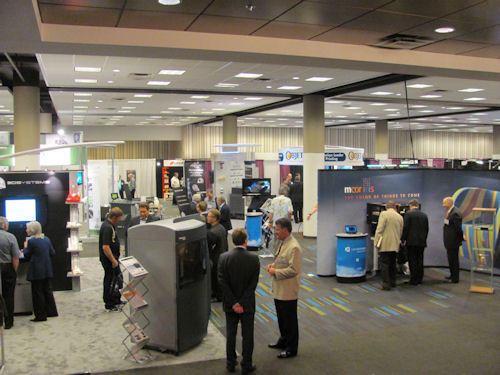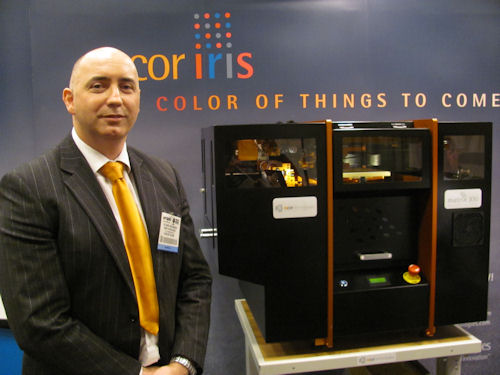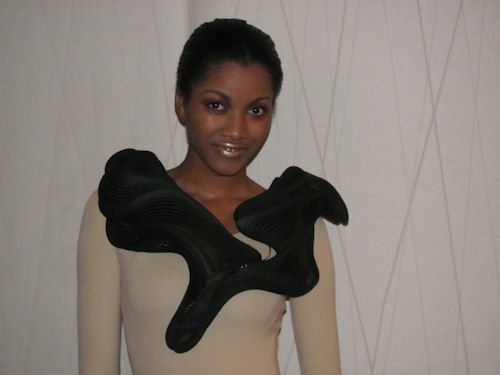A Look Back at RAPID 2012
Latest News
July 2, 2012
By John Newman
As 3D printing gathers steam, people familiar with the additive manufacturing (AM) industry and newcomers alike want to see the latest developments and talk with AM experts. To fill that desire for knowledge, the Society of Manufacturing Engineers (SME) holds RAPID, one of North America’s largest AM conventions.
 |
| RAPID 2012 gave attendees the chance to see what’s new in the world of additive manufacturing. |
RAPID’s place as the premiere AM event in North America is best summed up by the man responsible for Wohlers Report, the exhaustive yearly report on AM.
“RAPID has become the most important meeting place in North America for those involved with additive manufacturing,” says Terry Wohlers, president, Wohlers Associates.
RAPID 2012 began quietly with a number of concurrent AM sessions, then kicked into gear with SME’s Rapid Technologies & Additive Manufacturing (RTAM) Community Tech Groups program. The “Conference Kickoff” program featured a number of speakers, and was dedicated to highlighting AM innovations.
The field of 3D imaging was covered in broad strokes, covering topics such as industrial CT scanning, dental imaging (which is quickly becoming a field all its own), human body imaging (prosthetics, custom-fit clothes) and large-scale scanning. The Kinect received a brief mention as a commonly available 3D imaging tool, along with consumer photogrammetry (using digital cameras to produce 3D images).
Other topics of interest included AM-related medical applications, education, industry updates, a look at the European market, a concerted effort to standardize process terminology, and a materials overview. Following the RTAM program, RAPID switched into party mode with a 3D printed fashion show, sponsored by AM service bureau and industry consultant Materialise. RAPID attendees were also treated to a number of 3D printed creations, including hats by milliner Elvis Pompilio, necklaces by Daniel Widrig and some truly interesting accessories by Niccolo Casas.
The first keynote address for RAPID 2012 was presented by Paul Doe, chief designer for the Prodrive rally car program. Prodrive is a leading motor sport provider in Europe. Doe spoke about how 3D printing has changed the way Prodrive modifies automobiles.
For its rally car program, Prodrive begins with a brand-new Mini Countryman Cooper S. A typical rally car is vastly different than standard street vehicles, and by the time the Prodrive team is finished, nearly every part of the car has been replaced or modified in some way. Prototypes made using AM allow the work to be completed more quickly and cost effectively.
Following the keynote, the show floor opened its doors. Just under the tumult of conversation was the sound of multiple 3D printers humming away. Many industry manufacturers use RAPID as a venue to demonstrate their newest systems, and this year was no exception. Stratasys was showing off its new Fused Deposition Modeling printer, Mojo, and Objet had its newest polyjet offering, the Objet30 Pro, on display. The 3D Systems booth was busy with people looking for details about the new ProJet 3500 Series, ProJet 7000 Series and the recently revealed ZPrinter 850.
Mcor Technologies made its first appearance across the pond, showing off the Matrix 300 and announcing a new, full-color AM system to be released in the fourth quarter of 2012, the Iris. According to Mcor, the new printer was named after the goddess of the rainbow. For those unfamiliar with Mcor Technologies, the company uses standard office paper as its material of choice. The systems designed by Mcor lay down paper a sheet at a time, where it’s cut before being attached to the next sheet by a water-based adhesive.
“We see full color as an essential offering to our customers,” says Dr. Conor MacCormack, founder and CEO. “We think in color, so our 3D parts should be in color.”
 |
| Dr. Conor MacCormack, founder and CEO of Mcor Technologies, introduces the Matrix 300. |
Other manufacturers represented at the conference were ExOne and EnvisionTEC, along with a number of small business/hobbyist providers such as Fabbster and Delta Micro Factory. ExOne was showcasing its manufacturing-driven AM systems, including its resin-infused, sand mold casting S-Max. The S-Max has a whopping building envelope of 23x12x9.4 ft., and is intended for use in foundries and design facilities.
Keynote Revelations
The final day of RAPID began with a keynote speech by Wohlers. He began by informing the crowd that this was the 20th year of RAPID. The industry has changed quite a bit over the last two decades. According to Wohlers, since 1988, AM’s compound annual growth rate (CAGR) has increased by 26.4%. Approximately 6,500 industrial AM systems were sold in 2011, and material sales to feed those systems added up to $327 million.
Another area of growth for AM is what Wohlers calls “personal 3D printers.” According to Wohlers, any printer that costs under $5,000 is included in this category. Systems that fall into this category are produced by MakerBot and Solidoodle, along with the audience targeted by 3D Systems with its Cube. Hobbyists creating 3D printers using open-source systems, such as RepRap, are also included.
Wohlers says quantifying just how many personal 3D printer units have been sold is more difficult, partially because it’s harder to track small start-up sales—and even harder to guess how many hobbyists are building their own printers. He estimates that around 23,265 personal 3D printers were sold in 2011, up from 5,978 in 2010.
Looking Ahead
AM goes hand-in-hand with 3D imaging and design. Desktop Engineering spoke with Geomagic CEO Ping Fu. Geomagic, provider of 3D imaging and metrology software, recently acquired Sensable, creator of haptics devices. Asked how the acquisition might affect Geomagic in the short term, Fu said that Sensable brings an improved workflow for design.
 |
| The fashion show was a hit with RAPID attendees. |
As an example, when working with a sculpt, the new workflow will allow a single sculpt to be rethought and virtually redesigned, rather than creating a resculpt. Fu also told DE she believes haptic feedback is the future of design. She said that adding touch to the process will bring a sense of “digital reality” to prototyping, as well as medical and engineering applications.
DE was also able to sit down with Dr. Brent Stucker, professor of industrial engineering and Clark Chair of Computer Aided Engineering at University of Louisville, KY. Stucker is working with ASTM to produce standardized terminology for AM processes, materials and testing. Standardized process names would bring welcome clarity to what can be a confusing mix of process terminology. In place of the muddle of terms used by individual companies (it isn’t difficult to find six different trademarked descriptions for what amounts to additive laser technology, for example), ASTM has created a list of standardized terminology to cover the spectrum of AM. See rapidreadytech.com/?p=1616 for the list of terms.
All of that is just a taste of what RAPID 2012 had to offer. In addition to the keynote programs, speakers covered a gamut of AM topics. These included Michael Mock of INUS Technology, who discussed 3D scanning, and Andreas Berkau of citim GmbH, who covered using AM as an alternative to aluminum casting. Next year is sure to be even bigger, given the recent focus on additive manufacturing by the U.S. government. Make sure to watch DE and its AM blog, Rapid Ready Tech, for details of RAPID 2013.
John Newman is a contributing editor for DE, and the lead writer on DE’s Rapid Ready Technology blog at rapidreadytech.com.
More Info
Subscribe to our FREE magazine, FREE email newsletters or both!
Latest News
About the Author
John NewmanJohn Newman is a Digital Engineering contributor who focuses on 3D printing. Contact him via [email protected] and read his posts on Rapid Ready Technology.
Follow DE





